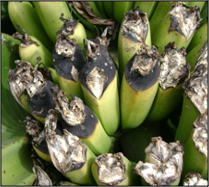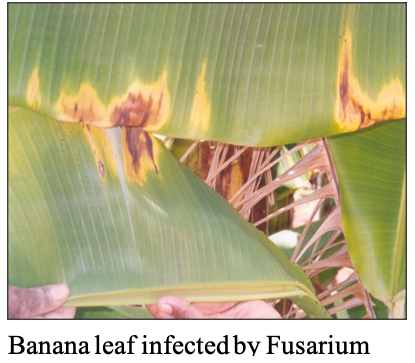Banana
Introduction
- Banana is an important staple and nutritional food which play a key role in food security and income generation among the small holder households in Kenya.
- The fruit is a rich source of carbohydrates (22%), fibre (7%), minerals (calcium, phosphorus and iron) and vitamins (vitamin A, B, and vitamin C).
- Banana is broadly grouped, according to utilization into dessert, cooking and dual purpose cultivars.
- Banana is a tropical crop that grows between the equator and latitudes 200 N and 200 S and from 0-1800m above sea level.
- Rainfall of at least 1000m per year is required and should be evenly distributed.
- Optimum temperature for growth is 270C. Below 160 C and above 380 C growth ceases.
- The soil should be deep, well-drained loose loams with high fertility and organic matter contents.
- Ideal PH is 5.8-6.5.
- Banana groups are organized into cultivar sub-groups which include Cavendish, Gross Mitchel and East African Highland
- Grand Nain, William hybrid, Valery and Lacatan cultivars belong to Cavendish sub-group.
- Kampala is a major cultivar in Gross Mitchel sub-group while Uganda green, Ngombe and Nusu-Ngombe are important cultivars in the East African Highland sub-group
- Bananas are also classified on basis of utilization into dessert (ripening), cooking and dual-purpose cultivars. Cavendish and Gross Mitchel sub-groups are basically dessert cultivars/varieties.
- East African Highland are for both cooking and ripening.
|
Dessert Cultivars (Ripening type)
Grand Nain Variety
|
These include: Grand Nain, Gross Mitchel, Williams hybrid, Lacatan, Valery, Chinese Cavendish, Giant Cavendish, Dwarf Cavendish, Fhia 17, Fhia 23 and Apple banana.
Dwarf Cavendish |
|
Cooking cultivars
Mbolokoma |
These includeUganda Green, Ng’ombe, Nusu Ngombe Gradi Shisikame, Mutahato, and Mbolokoma. Mbolokoma
|
|
Ng’ombe Variety
|
|
|
Dual purpose (Ripening and cooking types)-Muraru, Pelipita and Goldfinger.
|
|
|
Fhia 17 Bunch display at Farm Tech exhibition at KALRO Naivasha. |
|
- Shelter the site from prevailing winds.
- Avoid known hail belts or storm areas.
- Avoid areas prone to water logging or salinity.
- Ensure proximity to water supply for irrigation when necessary.
- Analyze the soil for pH and nutrient corrections.
- Deep-rip to break hard pan and to remove tree/shrub-roots which can be source of disease-infection.
- Harrow to at least 20cm deep to produce a fine tilth and reduce compaction
- Prepare large planting holes by hand where deep ploughing may not be possible.
- Undertake soil conservation measures on sloping land of more than 25%.
- Construct bench terraces to cater for single or double rows of banana plants.
- Construct contour channel banks on slopes less than 25%.
- Cover the banks with a binding grass
Hole preparation
- Dig planting holes 60x60x60 cm or 90x90x90 cm in drier areas.
- Mix top soil from 0-30cm with 2 debes of well decomposed manure and 200g of DAP (Diammonium phosphate) or TSP (Triple super phosphate).
- Return half of the mixture to the hole to a depth of 30cm after which the planting material is placed into the hole and the rest of the soil worked in.
Zai Pits
- The technology is suitable for areas with unpredictable rains especially the drought-prone areas in the ASALs.
- The pits store water for crop use.
- Dig the pits measuring 60- 90 cm in width, 60-80 cm deep and spaced 60-80 cm between them.
- Plant the suckers/plantlets into the pits after filling with two debes of organic material e.g. manure, compost, or dry plant biomass.
Plant spacing
- Space out the holes depending on the cultivars
- Tall cultivars are spaced at 4.0mx4.0m (625 plants/ha)
- Medium cultivars 3mx3m (1110 plants/ha)
- Short cultivars 3mx2m (1667 plants/ha)
Weed Control
- Light hand-hoe the weeds since bananas have shallow roots
- Weed regularly especially before the leaf-canopy can suppress weed growth
- Use paraquat herbicide on broad-leaf weeds while glyphosate is applied on grasses, but only when the plants are over 2m tall and the leaf canopy is raised.
Fertilizers
- Apply fertilizers twice a year during the rainy seasons
- Apply at least 2 debes of manure per stool every year mixed with 200g of CAN.
- Other fertilizer requirements are guided by soil analysis
Sucker Management
- Bananas produce suckers about 2 months after planting.
- Remove unwanted suckers to reduce competition for the mother plant and the follower sucker
- Select 3 vigorous sword suckers on the Eastward side or up the slope (where the land is sloping)
- Cut all the other suckers and gorge out the middle to kill the growing point. One to two months later
- Select the most vigorous sucker among the 3 and remove the rest within two months.
- Thus a stool should have: One bearing or nearly bearing mother plant; one large daughter sucker and one small granddaughter ("Peeper").
Mulching
- Mulching conserves moisture, reduces weed growth, soil erosion, soil compaction and increases soil fertility.
- Use the mulches available, e.g. dead organic mulch (banana leaf and pseudo stems, grass, coffee husks)
- Use living mulch such as legume cover crop intercropped with bananas (groundnuts, beans).
- Spread the mulch evenly and keep it away from the base of the plant
- Dead or dried leaves which hang down the pseudo stem should be removed and can be used as mulch.
- Green functional leaves should never be removed as this reduces bunch weight.
- Leaves which are scaring or rubbing the fingers should be removed to improve fruit quality.
|
Propping
Propping up Giant Cavendish bunch |
|
|
|
|
|
|
|
||
|
Black Sigatoka Sigatoka-infected banana leaf
|
|
|
|
Management of Banana Xanthomonas Wilt (BXW) |
|
|
Nematodes
- There are four major species of nematodes affecting bananas
- Lesion nematodes
- Burrowing nematodes
- Spiral nematodes
- Root-knot nematode
The burrowing nematode is especially a serious pest of bananas in Coast, Western and Nyanza region where a marked yield decline has been reported.
- The first above ground symptoms are yellowing of the leaves, later, growth ceases and shoot development is stunted and, finally, mature plants may fall over.
- In advanced stages of infestation, root examination will show brown lesions especially near the rhizome.
- These brown lesions are particularly clearly seen when an affected root is split longitudinally and examined immediately.
- The all stages of the nematode can be found in the root region of the plant.
- Pest is spread on suckers and corms sourced from infested fields .
Banana Weevil
- Injury is caused by the larva of the weevil feeding on the rhizome and pseudo-stem at ground level, making irregular tunnels.
- The tunnels are roughly circular increasing in size with the growth of the larvae.
- A rhizome with numerous tunnels is reduced to blackened mass of rotten tissue.
- In some cases, the tunnels may extend one to two metres up the pseudo-stem.
- Destruction of the rhizome prevents translocation of nutrients and consequently the leaves turn yellow, wither and die prematurely.
- The adult weevil is black or brown-black, curved about 12mm long, hard shelled and with a pronounced snout.
- The weevils are nocturnal and hide during the day in or around the corms or between leaf-sheaths above the ground level.
- Infested plants are easily blown over by wind.
Control of weevils and nematodes
- Tissue culture plants are usually free of pests but should be planted in clean fields.
- Remove all the roots from the sucker, trim the tuber up to 0.5cm deep and cut off all the lesions and weevil tunnels
- The trimmed suckers are immersed in hot water 550 C for 20 minutes and/or dipped in a nematicide solution overnight
- Use of a break crop that is not affected by weevils and nematodes of banana plant such as sweet potato can be grown in an infested field for 2 years
- This kills the pests and banana can be replanted
- Deep planting prevents the weevil from laying eggs on the corm.
- Trapping the adult weevils by use of freshly cut pseudo stem- and corm-pieces placed facing downwards on the ground around the stool to attract them and can easily be collected and destroyed
- Field hygiene should be practiced keeping the field weed-free, old pseudo stems are cut into small pieces to hasten drying and rotting
- The cut surface of the corm should be covered with soil to reduce weevil attraction.
Banana silvering thrips
- The adult is dark brown and about 1.5mm long with 2 pairs of fringed wings
- The adult thrips inserts its eggs into the fruit tissue, especially where two banana fingers touch.
- The nymphs feed on banana fruits, producing silvery patches which later turn brown and are covered with black dots of feces.
- Under heavy infestation, the skin of the fruits may crack longitudinally permitting the entry of fruit rot causing bacteria and fungi
- The nymphs are yellowish with swollen abdomen which appear black due to the presence of liquid feces.
- The damage to the fruit is normally superficial and affects the external appearance of the fruit reducing its market value
- Chemical control on the fruit is feasible in a properly maintained orchard where pruning and thinning are regularly done.
- Almost all crop production in Kenya is rain fed.
- Rainfall variability and drought to crop production is a real threat to crop production and food security The drip irrigation offers an opportunity to produce food with limited water
- Technologies such as drip irrigation systems for crop production increase yields and conserves water for other uses
- Soil fertility has been declining leading to low orchard productivity.
- Many small scale banana farmers lack resources to purchase chemical fertilizers thus green manure would be a good alternative
- Use of nitrogen-fixing perennial or annual plants parts, in rotation or intercropped, either applied to surface or incorporated into the soil in between the banana plants will enhance fertility
- Application of a combination of 20 kg of well decomposed farm yard manure (dry) plus 200 g of basal phosphate fertilizer (DAP, Mavuno planting, TSP) has also been used in banana orchards.
Conventional suckers
- Narrow leaved sword suckers are recommended.
- Remove when 1-2m tall.
- All the roots should be removed and the corm pared and the leaves cut.
- Dip the trimmed suckers in hot water at 550 C for 20 minutes to control nematodes and weevils.
Tissue culture plantlets
- Tissue culture plantlets are grown from the tissue of the banana plant in a laboratory and subsequently transplanted into bags for hardening in a greenhouse
- The technology is the preferred method for banana planting material for various reasons
- Improved propagation methods to control pests and diseases.
- Uniformity in production.
- True to type plants.
- TC plants are transplanted when they are at least 30 cm tall, have 5 healthy dark green leaves, be in a 2 litre plastic bag and should be free from pests/
TC plantlets in a hardening nursery
Planting
- Plant to coincide with the on-set of the rain season.
- Place the sucker or tissue culture plantlet into the hole ensuring the base is covered with the soil/manure/fertilizer-mixture to the previous soil-level.
- Water the plant if rain is not adequate
- Plant drought-tolerant varieties such as William and FHIA where rainfall is not well distributed.
Deep banana planting technology
Inter-cropping
- Intercropping refers to cultivation of bananas with another low growing crop such as a legume, such as bean, in the same piece of land.
- The system maximizes land utilization and labour inputs.
- Legumes avail nitrogen from the air into the soil for the plants to use
Intercropping banana and beans
- Flowering begins 8-12 months after planting depending on the climate and management.
- The fruit matures 3-4 months after flowering
- Harvest the fruits when they are three quarters round and appear light green and shiny
Yield
- Under good management average yields of 30- 40 tons/ha can be achieved.
Packing
- De-hand the banana before packing
- Hang the bunch on the de-handing rail and using a sharp chisel or knife cut off the crown from the bunch stem
- Leave the banana-hands to bleed in water for 10 minutes then split into units of 5-6 fingers
- Wash the units, remove flower-remains and dry the hand-splits on clean benches.
- Sort out the damaged, deformed and lose fingers
Dip the hand-splits in Benlate solution (1gm/litre of water) or any other appropriate fungicidal dip, to control crown rot
Pack the graded bananas in wooden or plastic crates (64 cm x 44 cm x 30 cm) lined with a polythene sheet.
Graded banana hands for ripening/sale
Banana ripening Chamber
- Pack the banana-crates in a ripening chamber and introduce the ripening gas (Ethylene) from ethylene source e.g. passion fruit, avocado, papaya placed in the chamber sump
- Close the chamber for 24-30 hours and then open to release carbon dioxide for the peel color to break.
Banana products
- Banana powder – flour or powder is produced by dehydration used in bread and ice-cream manufacture
- Dried banana figs
- Banana starch
- Banana juice
- Banana wine
- Canned banana slices
To make banana juice, peel each banana and remove the extra fibers from the side of the fruit
Making banana juice
- Slice the bananas into chunks
- Add the banana chunks, milk and honey to a blender (Add 1-2 ice cubes, if desired).
- Blend the mixture for 2-3 minutes, until it has an even, thin consistency
Zero Energy Brick Cooler (ZEBC)
- The cooler is a low cost postharvest temperature management that improves the shelf life of banana using less power.
- Cooling results from evaporation of water from the surface of porous materials such as sand or bricks
- The evaporating water reduces the temperature of the air within the chamber compared to the ambient temperature
- The technology extends the keeping quality of bananas by at least 2 weeks in relation to the ones outside the cooler
The Coolbot™
- A small electrical device that uses an off-the-shelf air conditioner that produces cold air in a well-insulated room maintaining temperature at 4°C.
- Diversification of banana food products will enhance consumption of banana, as well as spur demand which may increase production
Use of banana-flour will reduce over-reliance on maize-flour for human consumption in the Country
Bananas can be processed to make flour, which can either be fortified or used to make nutritious porridge, or mixed with wheat flour (ration of 1:1) to make various bakery products such as chapati, mandazi, bread and cakes. Ripe plantain-banana can be deep-fried to make sweet chips or are roasted
Over-ripe bananas with a fine flavor and texture can be used to make juice, jam and/or wine.
Machinery for use on the farm can be hired when required
- Cost of inputs may vary from one area to another
- On average
- Basic costs KES 100,000-120,000 per acre of banana for 18 months
Estimated returns KES 450,000-500,000 per acre per year for five years
- Common interest farmer-groups and cooperatives have better bargaining power in marketing.
- Availability of domestic and international markets for the commodity is big.
- KALRO HRI Banana Brochures (Banana Production and Banana varieties).
- Muchui M, Kamau E. (2013). Enhancing small scale banana production through field schools in Eastern Kenya.
- Nguyen van Thanh (2015). 1st International Conference on Asian Highland Bananas
- Valerie A. Pearson, Banana Production. ARC-Institute for Tropical and Subtropical Crops, Nelspruit.
- https://www.kalro.org/sites/timps/KCSAP%20TIMPs%20-%20Banana%20June2019.pdf
Contacts
Kenya Agricultural and Livestock Research Organization
P.O. Box 57811-00200, Nairobi, Kenya
Call: 0111010100
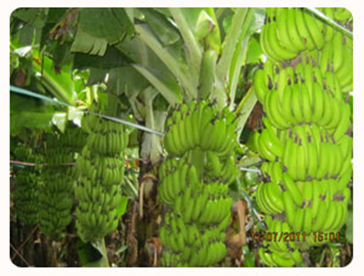
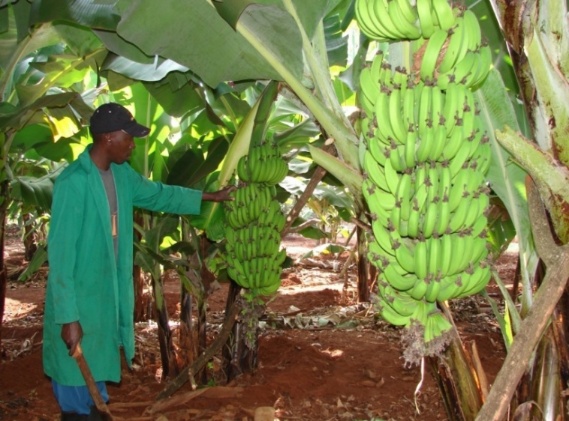
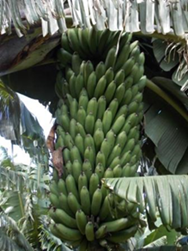
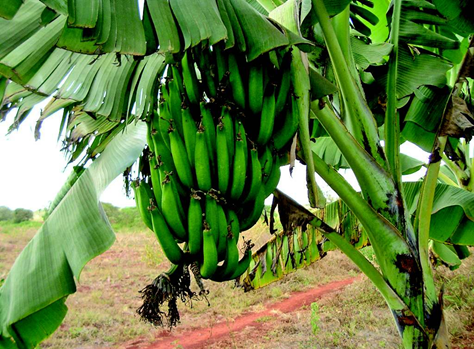 Muraru variety
Muraru variety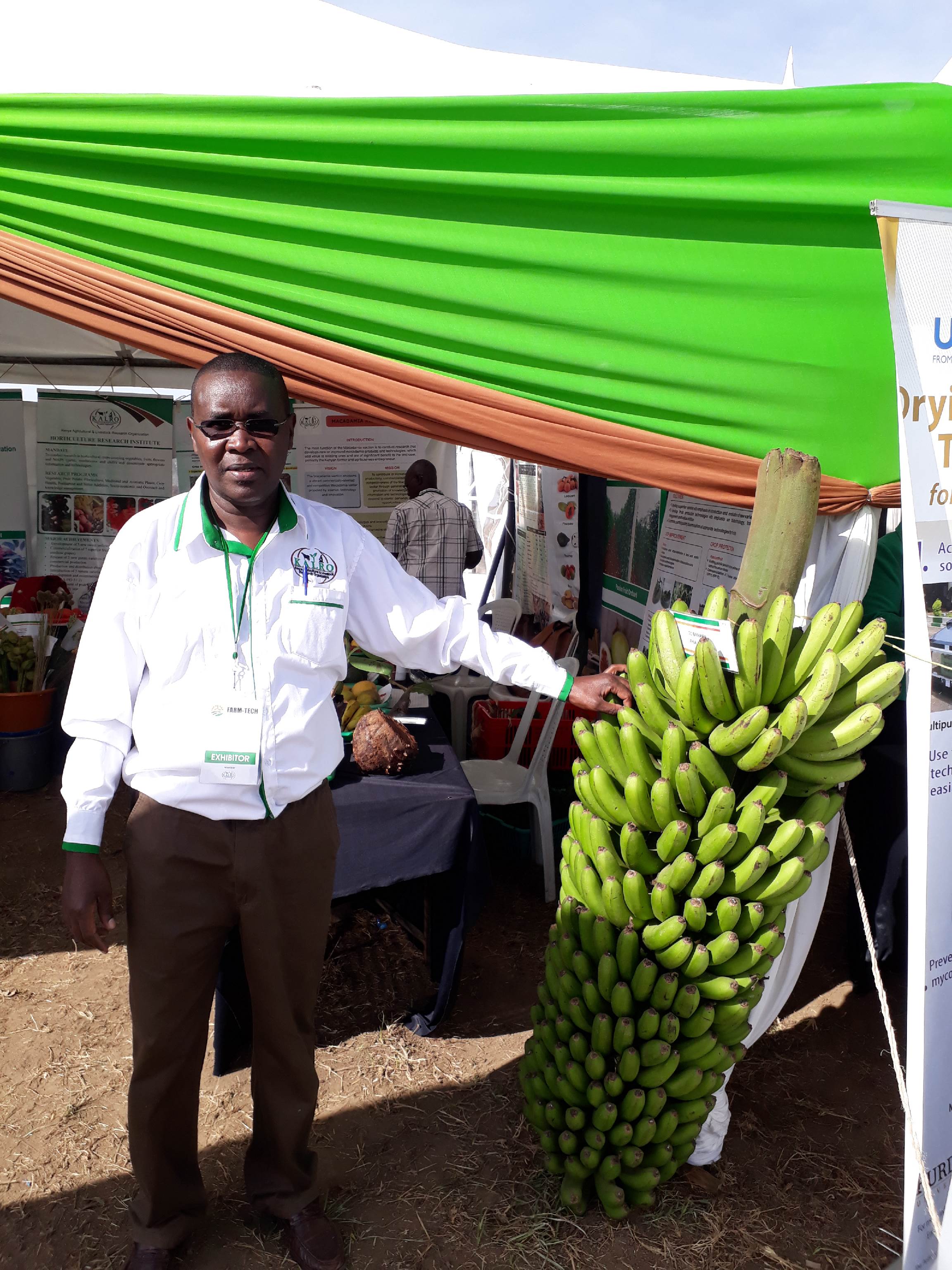 Fhia 17 variety
Fhia 17 variety
